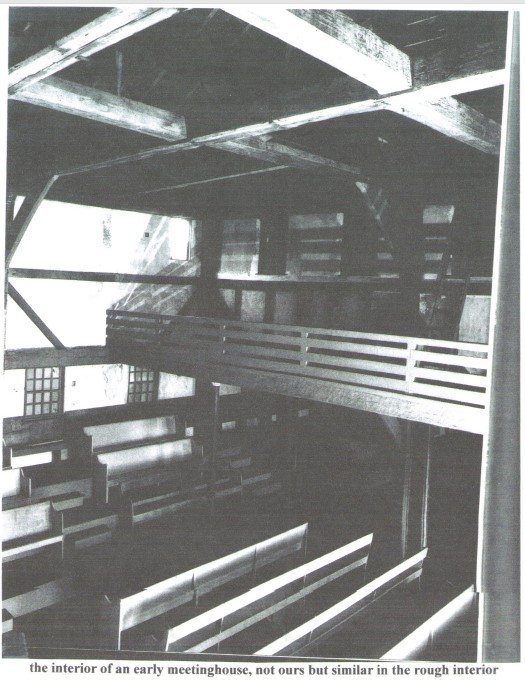Floor Plan for the Original Meetinghouse

The floor plan of the meetinghouse was discovered in the church safe and was drawn by Rev. Noyes who was very interested in old buildings and Wilmington history. The notation in the upper right hand corner took ages to figure out. The only writing appears on the upper right. The seating arrangement was written in per the history written by Rev. Noyes.
Typical of all the early meetinghouses, wealth, prestige and age were all factors to be considered when, long before the building was begun, the seating plan was drawn up. This was important as they couldn't have people wandering in and sitting down just anywhere.
Samuel Dummer, Esq., who held the pew to the right of the pulpit, was very wealthy and related to Lieutenant Governor, William Dummer. Those credentials seemed to be all he possessed but apparently they were enough to grant him his honored pew. He served no part in working to create the township and his name does not appear on any of the membership lists. According to the old records he died in Wilmington in 1738, at the age of 48. There is no note of anyone else taking over his pew in the meetinghouse.
 The only writing on the original plan is at the upper right. It is an explanation for the dotted lines which appear on either side at the front. The notation states: The dotted lines indicate "balusters separating the seats in the church from the others." The "others" refer to the benches against the inner front walls. Those benches were probably needed for extra seating during town meetings but to have them available for worship would have seemed unseemly. Only those chosen few were allowed to sit so close to the pulpit. The balusters or railings made it possible to keep the front benches closed off on the Sabbath.
The only writing on the original plan is at the upper right. It is an explanation for the dotted lines which appear on either side at the front. The notation states: The dotted lines indicate "balusters separating the seats in the church from the others." The "others" refer to the benches against the inner front walls. Those benches were probably needed for extra seating during town meetings but to have them available for worship would have seemed unseemly. Only those chosen few were allowed to sit so close to the pulpit. The balusters or railings made it possible to keep the front benches closed off on the Sabbath.
The meetinghouse floor plan shows no placement of windows. From the history by Rev. Noyes, we know there was a small pulpit style window with a curved top directly above the pulpit. Also, when the meetinghouse was enlarged, he described the new windows as having larger panes of glass which replaced the smaller diamond shaped panes. On the first floor the windows would have been behind the stairs to the gallery.
On the second floor, Rev. Noyes' address describes the gallery seating as going right up under the eaves so whether there could have been windows behind the gallery seats seems unlikely but not possible. There seems to be no way of knowing for sure.
The front door of the meetinghouse opened into the main aisle leading straight to the pulpit, which was high and reached by two flights of stairs. The deacons' pews with its communion table was directly in front of the pulpit. There was no ceiling, instead it was open up to the roof. The galleries went around three sides of the building, with seating going close up under the eaves. The house was filled with strong benches having backs. The minister's pew or "parsonage pew" was situated directly in front of the pulpit. The rest of the congregation were assigned their proper places according to public office, age, wealth, respect and so on. The men were situated on the left side of the center aisle and the women on the other. The quality tapered down to the back benches where the young men who had recently graduated from under the tithing man's rod were seated. The young boys were arranged in the west gallery under the strict supervision of the tithing man.
Researched and written by Andrea Houser
Typical of all the early meetinghouses, wealth, prestige and age were all factors to be considered when, long before the building was begun, the seating plan was drawn up. This was important as they couldn't have people wandering in and sitting down just anywhere.
Samuel Dummer, Esq., who held the pew to the right of the pulpit, was very wealthy and related to Lieutenant Governor, William Dummer. Those credentials seemed to be all he possessed but apparently they were enough to grant him his honored pew. He served no part in working to create the township and his name does not appear on any of the membership lists. According to the old records he died in Wilmington in 1738, at the age of 48. There is no note of anyone else taking over his pew in the meetinghouse.
 The only writing on the original plan is at the upper right. It is an explanation for the dotted lines which appear on either side at the front. The notation states: The dotted lines indicate "balusters separating the seats in the church from the others." The "others" refer to the benches against the inner front walls. Those benches were probably needed for extra seating during town meetings but to have them available for worship would have seemed unseemly. Only those chosen few were allowed to sit so close to the pulpit. The balusters or railings made it possible to keep the front benches closed off on the Sabbath.
The only writing on the original plan is at the upper right. It is an explanation for the dotted lines which appear on either side at the front. The notation states: The dotted lines indicate "balusters separating the seats in the church from the others." The "others" refer to the benches against the inner front walls. Those benches were probably needed for extra seating during town meetings but to have them available for worship would have seemed unseemly. Only those chosen few were allowed to sit so close to the pulpit. The balusters or railings made it possible to keep the front benches closed off on the Sabbath.The meetinghouse floor plan shows no placement of windows. From the history by Rev. Noyes, we know there was a small pulpit style window with a curved top directly above the pulpit. Also, when the meetinghouse was enlarged, he described the new windows as having larger panes of glass which replaced the smaller diamond shaped panes. On the first floor the windows would have been behind the stairs to the gallery.
On the second floor, Rev. Noyes' address describes the gallery seating as going right up under the eaves so whether there could have been windows behind the gallery seats seems unlikely but not possible. There seems to be no way of knowing for sure.
The front door of the meetinghouse opened into the main aisle leading straight to the pulpit, which was high and reached by two flights of stairs. The deacons' pews with its communion table was directly in front of the pulpit. There was no ceiling, instead it was open up to the roof. The galleries went around three sides of the building, with seating going close up under the eaves. The house was filled with strong benches having backs. The minister's pew or "parsonage pew" was situated directly in front of the pulpit. The rest of the congregation were assigned their proper places according to public office, age, wealth, respect and so on. The men were situated on the left side of the center aisle and the women on the other. The quality tapered down to the back benches where the young men who had recently graduated from under the tithing man's rod were seated. The young boys were arranged in the west gallery under the strict supervision of the tithing man.
Researched and written by Andrea Houser

